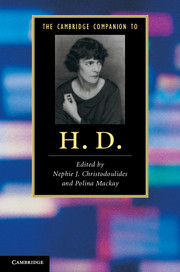Book contents
- Frontmatter
- Introduction
- PART I CONTEXTS AND ISSUES
- 1 ‘Uncanonically seated’: H.D. and literary canons
- 2 Facts and fictions
- 3 H.D. and the ‘little magazines’
- 4 H.D.'s modernism
- 5 H.D. and gender: queering the reading
- 6 Reading H.D.: influence and legacy
- PART II WORKS
- Further reading
- Index
- Cambridge Companions to…
2 - Facts and fictions
from PART I - CONTEXTS AND ISSUES
Published online by Cambridge University Press: 28 November 2011
- Frontmatter
- Introduction
- PART I CONTEXTS AND ISSUES
- 1 ‘Uncanonically seated’: H.D. and literary canons
- 2 Facts and fictions
- 3 H.D. and the ‘little magazines’
- 4 H.D.'s modernism
- 5 H.D. and gender: queering the reading
- 6 Reading H.D.: influence and legacy
- PART II WORKS
- Further reading
- Index
- Cambridge Companions to…
Summary
In her 1949–50 essay ‘H.D. by Delia Alton’, H.D. exemplified the dialogic nature between her life and work, an understanding of autobiography she had consciously introduced as early as 1920 in her first extant novel, Paint It Today. Delia Alton, her nom de plume, authors H.D.; though only a textual self, she ‘writes’ H.D. the woman, thus conjoining life and work. The dialogic nature between H.D.'s life and her ‘highly autobiographical’ work casts into sharp relief the way she, much like Sylvia Plath, manipulates life ‘with an informed and intelligent mind’: while writing, she is being written.
H.D.'s autobiographical method does not promise revelation, nor do her texts uncover a miraculously intact female subject. Instead, the autobiographical subject finds herself on multiple stages simultaneously; thus, her work is partly a process of fabrication and replenishment, a rewriting of life to generate a new textual identity by appropriating myths and revisiting personal history. H.D.'s work represents the self as produced not by experience, but by autobiography itself, ‘[t]he story must write [her]. The story must create [her]’ and, as if in accordance with Olney, she ‘creates a self in the very act of seeking it’. Her quest is bi-focal: she needs to determine her poetic vocation in a patriarchally dominated world, and second, to come to terms with her sexuality, which is amorphous and ambivalent, vacillating between homo-eroticism and a heterosexuality related to her quest for the eternal lover.
- Type
- Chapter
- Information
- The Cambridge Companion to H. D. , pp. 23 - 36Publisher: Cambridge University PressPrint publication year: 2011

